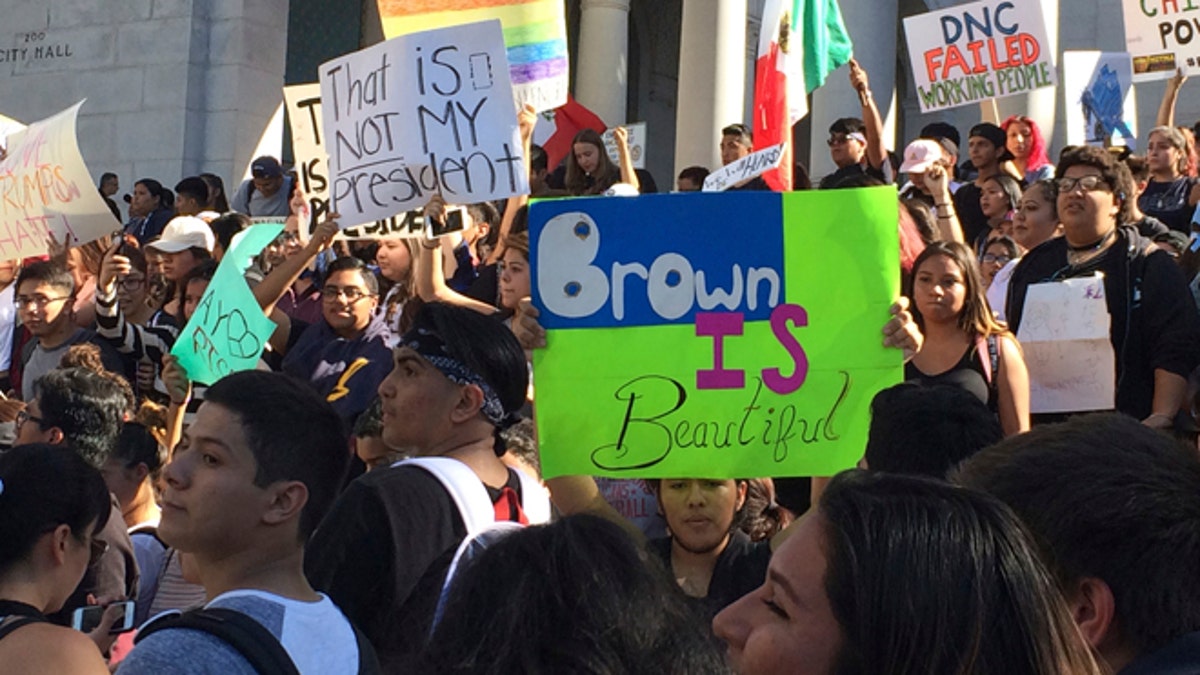
High school students protest against the election of President-elect Donald Trump on the steps of Los Angeles City Hall Monday, Nov. 14, 2016. Students from several Los Angeles schools have walked out of classes to protest the election of Donald Trump as president. (AP Photo/Reed Saxon) (Copyright 2016 The Associated Press. All rights reserved.)
Abraham Lincoln’s election in 1860 led South Carolina to try to secede from the Union. Donald Trump’s election last month has raised similar talk in California, known as the “California Independence Campaign.”
Billionaire activist Tom Steyer said in that aftermath of the election that, “It’s impossible to look at the Trump campaign and not see a direct threat to the civil liberties and dignity of California citizens.”
The leftist anti-constitutionalist Jeff Rosen is also touting “States’ Rights for the Left” in a recent opinion piece.
California can’t secede. The Civil War settled that. But there are other potential avenues by which the Golden State can leave the Union: unanimous consent, retrocession, and deannexation.
California might be able to exit theoretically — and certainly could practically — if nobody objected. Lincoln himself entertained this possibility in his first inaugural address. If the Union were “but an association of States, in the nature of contract merely,” he suggested, it could be “peaceably unmade” by unanimous consent of all the States.”
Lincoln was speaking arguendo (for the sake of argument). He did not believe that the Union was a contract among the States. Even so, he recognized that he could not stop an illegal secession if his “rightful masters, the American people,” did not furnish “the requisite means” to stop secession.
Though President Obama would probably have held the door open had Texas tried to secede during his presidency, President-elect Trump is not likely to let California go in peace.
Another alternative is to let California go out the way she came in. The common historical view is that the United States “conquered” California (along with Texas and the rest of the Southwest) in the Mexican “war of aggression” of 1846-48. This is true as far as it goes, but incomplete.
Technically, we acquired California as part of the Mexican “cession” in the 1848 Treaty of Guadelupe-Hidalgo. The U.S. paid Mexico $15 million for this territory. In a similar way, the states of Maryland and Virginia “ceded” the territory that is now the District of Columbia to the United States. In 1846 the federal government “retroceded” the territory south of the Potomac back to Virginia.
So, why couldn’t we cede California back for, say, $415 million (what $15 million in 1848 dollars is worth today)? Maybe that’s what candidate Trump and Mexican President Nieto were talking about last summer. The proceeds would pay for the border wall after all. San Francisco wouldn’t need to be a “sanctuary city” for Mexican illegals, it would be part of Mexico again.
While easier than “unanimous consent,” retrocession would be difficult if it required an old-fashioned treaty and ratification by two-thirds of the Senate. While President Obama would feel free to retrocede by “executive agreement” with his “pen and phone,” President-elect Trump would have proper constitutional scruples.
That leads us to a third scenario. California could go out the way that Texas came in.
The Texans (mostly illegal Anglo immigrants) won their independence from Mexico in 1836. Lincoln recognized the legitimacy of this exercise of the “right to revolution” (not “secession”). “Any people, anywhere” he said, “being inclined and having the power, have the right to rise up, and shake off the existing government, and form a new one that suits them better.”
The independent republic of Texas immediately applied to join the United States, but the U.S. did not want to offend its southern neighbor, nor aggravate the North-South division over slavery. In 1844 President John Tyler submitted a treaty to annex Texas to the Senate, but it was soundly rejected. Later that year Democratic nominee James K. Polk campaigned to annex Texas (and “all of Oregon”). When Polk won the election, Democrats took it as a mandate to annex, and did so by a simple majority in Congress rather than a Senate supermajority.
Donald Trump, Paul Ryan and Mitch McConnell might welcome a California exit by joint resolution. Indeed, they might want to initiate it and kick out California by joint resolution. While they’re at it, they might act on the Texas annexation provision that allows Texas to be divided into five states.
Down one California, plus four Texases — a new chapter for an updated edition of "The Art of the Deal."
